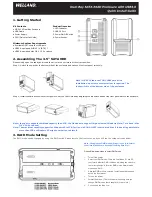
※
RAID 1
(
SAFE
)
Mode :
RAID 1
is the
automated process of writing data to multiple drives simultaneously. It is used to provide redundancy. If one drive fails, the
redundant drive(s) will rebuild the data. The failed drive can then be replaced and the drive set can be re-mirrored.
Note : When installing 2 equal drives, the capacity is equal to one of the two drives.
Note : When installing 2 unequal drives, the capacity is the smaller one.
6. Connecting The Drive
1. Connect one end of the USB cable into the USB Port of your HDD enclosure.
2. Connect the other end of the USB cable into any active USB port of the computer.
3. Connect power supply to the enclosure and power up the enclosure.
4. Let OS search and install the driver automatically.
5. Use the disk management tool (PC) or disk utility (MAC) to create a new partition and format the drives
6. Open “My Computer” to see your external hard drive ready to use.
Note : To enjoy USB 3.0 speed up to 5Gbps, your computer must be USB3.0 built-in or equipped with USB3.0 host PCI-e card.
7. Disconnecting The Drive
Caution
:
To prevent data loss, always shut down all active applications before turning off power.
Windows
1.
Double-click the Safely Remove Hardware icon in your system tray (typically located on the bottom right corner of your desktop).
2.
Select the appropriate device from the list and click "Stop". Click "OK" to confirm your selection of the drive to be disconnected.
3.
Click "Close" and ensure that the drive is powered off already.
MAC
1.
Find the Removable Disk icon associated with the drive that you want to disconnect and drag it to the Trash icon on your desktop.
2.
After the disk icon disappears from the desktop and the drive is powered off, you may safely disconnect the USB cable from your computer.
8. Rebuilding Hard Drive
One of the best reasons to use a RAID 1 array is that it automatically rebuilds after a drive-crash. The only thing the user will need to do is identify
and replace the malfunctioning drive. The on-board circuitry will rebuild your RAID 1 array silently in the backfground while you are able to
continue using your drive as normal.
It’s important to beware of the fault-tolerances of your RAID confiruguration. RAID 1 is the only mode that provides fault-tolerance. But if both
drives die before you can replace either one, then your data may well be lost.




